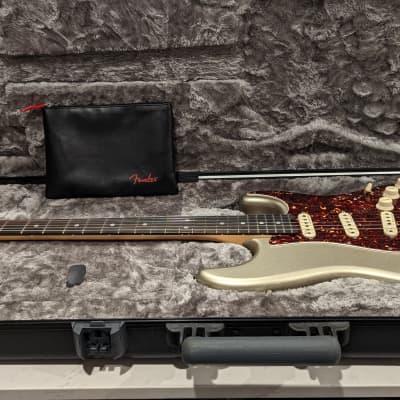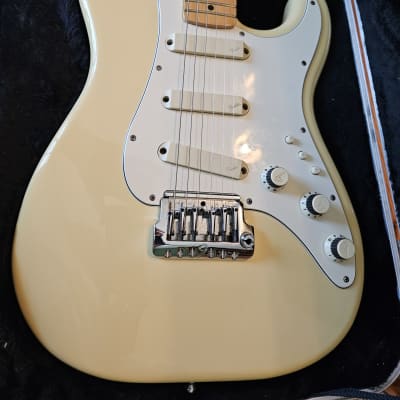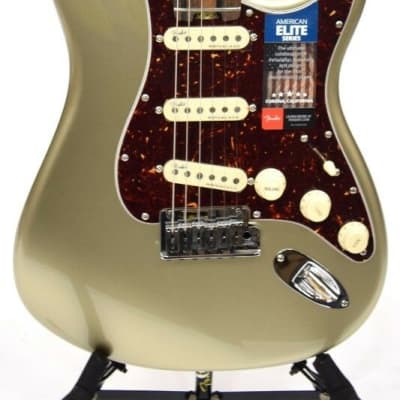Fender started work on the designs for the ELITE series in late 1981 with a research and design team that included Dan Smith, Chip Todd. John Page, Charlie Gressett and Freddie Tavares. The Elite series was meant to combine modern technologies with the classic Stratocaster design. The electronics, vibrato and neck adjustment mechanisms were all to be improved. To this end the Elite Stratocasters included active electronics, refined Freeflyte tremolo bridges and Biflex trussrods. When the Elite Stratocaster was finally released in 1983 it included numerous new features:
- Biflex truss rod adjustment (installed from the rear - with skunk stripe on neck) with a neck angle adjuster located in the neck plate
- Slightly wider nut width and flatter 12 inch fretboard radius
- Ezy-Glyder point contact string retainers and high ratio, low backlash machine heads with specially lubricated tuning gears
- Security lock strap buttons
- Heavy duty cast bridge assembly with 'drop-in' string loading, Freeflyte tremolo system with tension adjustable from the top and snap-in Torq-Master tremolo arm. There was no backplate or recess in the back of the body for tremolo springs.
- Alnico II single coil pickups without protruding poles, noise-cancelling pickup system with a dummy coil between the lead and the middle pickups and active electronics with a special preamp circuit including MDX (mid-range) and TBX (high-range) controls. There was a small backplate near the edge covering the 9-volt battery for the active circuitry.
- three separate pickup push-on-off selector switches, an edge-mounted jack output and control knobs with a serrated rubber insert
The Elite Series contained three models:
- the ELITE STRATOCASTER, heavy chrome-plated hardware,rosewood fretboard or a one-piece Maple Neck in 6 standard and 9 custom finishes. Retail price in 1983 was $995 (compared with $650 for a standard Stratocaster).
- the GOLD ELITE STRATOCASTER, same as the Elite Stratocaster except with gold-plated hardware and pearloid tuner buttons. Retail price in 1983 was $1155.
- the WALNUT ELITE STRATOCASTER, same as the Gold Elite Stratocaster with American Black Walnut body and neck and ebony fingerboard. Retail price in 1983 was $1295.
When it was introduced in 1983 the Elite Series replaced "The Strat" series THE STRAT, THE WALNUT STRAT and the GOLD STRATOCASTER were all dropped from the Fender price list of July 1, 1983. Some of the innovative features of the Elite found their way onto the regular Stratocaster, which was again revamped in mid-1983. The Fender Elite Stratocaster also formed the basis for the design of the 1988 Eric Clapton Signature Stratocaster.
Source: The Fender Stratocaster Book. A. Duchossoir (1989).
 | FENDER ELITE STRATOCASTERThe Fender Elite Stratocaster was made in the USA from 1983 to 1984. It was the basic model in the innovative Elite series and had various new features compared to the standard Stratocaster at the time including: |
| No image yet | FENDER Gold Elite StratocasterThe Gold Elite Stratocaster was introduced in late 1983 and made until 1984. Features included: |
 | FENDER Walnut Elite StratocasterFENDER manufactured the Walnut Elite Stratocaster from 1983 to 1984. It was the top of the innovative Elite Stratocaster range having gold-plated hardware, pearloid tuner buttons, American Black Walnut body and neck and ebony fingerboard. Other features included: |
Specifications:
| Model | Image | Finish colors | Finish effects | Made in | Number of strings | Scale length |
|---|---|---|---|---|---|---|
| FENDER ELITE STRATOCASTER 1983 to 1984 |  | blue finish, brown finish, gold finish, green finish, red finish | sunburst finish | USA | 6 strings | 25.5 inches scale-length |
| FENDER Gold Elite Stratocaster 1983 to 1984 | No image yet | gold finish | metallic finish | USA | - | - |
| FENDER Walnut Elite Stratocaster 1983 to 1984 |  | - | - | - | - | 25.5 inches scale-length |
| Model | Body material | Body style | Body shape features |
|---|---|---|---|
| FENDER ELITE STRATOCASTER 1983 to 1984 | alder body | Stratocaster style | - |
| FENDER Gold Elite Stratocaster 1983 to 1984 | - | Stratocaster style | - |
| FENDER Walnut Elite Stratocaster 1983 to 1984 | walnut body | - | double cutaway |
| Model | Bridge | Hardware color | Tuners |
|---|---|---|---|
| FENDER ELITE STRATOCASTER 1983 to 1984 | Freeflyte vibrato, tremolo bridge | chrome hardware | - |
| FENDER Gold Elite Stratocaster 1983 to 1984 | - | gold-plated hardware | - |
| FENDER Walnut Elite Stratocaster 1983 to 1984 | Freeflyte vibrato | gold-plated hardware | pearloid button tuners |
| Model | Fingerboard material | Fingerboard position markers |
|---|---|---|
| FENDER ELITE STRATOCASTER 1983 to 1984 | maple fingerboard, rosewood fingerboard | dot fingerboard position markers |
| FENDER Gold Elite Stratocaster 1983 to 1984 | - | - |
| FENDER Walnut Elite Stratocaster 1983 to 1984 | - | - |
| Model | Number of frets | Neck material |
|---|---|---|
| FENDER ELITE STRATOCASTER 1983 to 1984 | 21 fret | - |
| FENDER Gold Elite Stratocaster 1983 to 1984 | - | - |
| FENDER Walnut Elite Stratocaster 1983 to 1984 | - | walnut neck |
| Model | Pickup selector controls | Tone controls | Volume controls |
|---|---|---|---|
| FENDER ELITE STRATOCASTER 1983 to 1984 | 3 pickup selector switches | 2 tone controls | 1 volume control |
| FENDER Gold Elite Stratocaster 1983 to 1984 | - | - | - |
| FENDER Walnut Elite Stratocaster 1983 to 1984 | - | 2 tone controls | 1 volume control |
| Model | Pickups configuration | Preamp |
|---|---|---|
| FENDER ELITE STRATOCASTER 1983 to 1984 | 3 single coil pickups | active preamp |
| FENDER Gold Elite Stratocaster 1983 to 1984 | - | - |
| FENDER Walnut Elite Stratocaster 1983 to 1984 | 3 single coil pickups | - |




1 Comment
83 Walnut gold elite strat.
Submitted by Roger Lyness (not verified) on
This is a cool one. That fine tuner locking nut was completely unnecessary, so I took it off. I made an ebony pickguard and truss rod and battery covers, then ripped the active electronics out and put 2 SD 1/4 pounders in the bridge and neck position. I didnt make a hole for a middle pickup, so it was 2 single coils with gibson style wiring with a 3 way switch and an out of phase pull pot. Boy that guitar had the looks, the attitude and the tone. I bought it new in 83 when I graduated high school at 17. It was my only guitar until I got tele # 5291 which was customized for Jeff Beck by Seymour Duncan, for the Guitar Shop album, I bought it from Seymour at a guitar show in San Jose. I pulled out the strat when I needed more attitude. So, pretty soon I only used the tele. I had wired them both in stereo, so I had a stereo cord to the old marshall which I grafted a Hammond organ reverb unit into the high channel. The low channel got 2 more 12ax7's for four more gain stages. I could go from the clean reverb sound to the ultra gain low channel. I could mix them from the 2 volume knobs on the strat and the tele. It was great live, doing the 'swipe' to go from clean to dirty. When the band broke up, I rewired them both to mono. Then came the loma prieta earthquake. All kinds of fish tanks, cinder blocks and my beer bottle collection landed on it and broke the pickguard and dented the wood. We were literally crushed. So, I decided to go with 3 Seymours, SS-1's and SS-6's, 3 volume pots and 3 on/off/on out of phase switches. I wired up a $26 old Squire, from a garage sale, like that as well, because it played SO nicely and the trem stays in tune. I am not a whammy bar kind of guy, so I screwed the bridge to the body with a 1-1/4" drywall screw. I actually lost the gold vibrato bar.
Since it got beat up by the earthquake, it is a beater now, but it's one of the best strats i have ever heard or played. I put string end balls on the string trees on it. I love the thing. Fender did not glue the body together very well. The finish is cracking on the wood that was joined together for the body. It might come apart, I dont know, but the TONE is killer. I put out of phase pull pots on my mexi-tele, a ricky 620, a j-bass, a danelectro 12 string which also has a series/parallel pull pot. And a 76 SG and a les paul supreme 2011, which has no access plate on the back, so I had to do it thru the jack plate. I play them thru an English Muffin, a g-15 reverb and either my 63 twin, or my jimi hendryx marshall. When I plug the walnut strat into either amp, it sounds very unique. It has all of the alder/ash tone and more low end. It is a very versatile guitar. Some advice: modify your guitar all you want but keep the original parts. Play around with out of phase and series/parallel for your single coils and coil splits on all your humbuckers. Study the Jimmy Page les paul wiring. It has coil split on both pickups, series parallel, and out of phase, using pull pots on all 4 pots. Use higher pot values. I have a 1 meg on the SD tele. It makes it louder. I have 1 megs on my walnut strat as well. That just makes the pickups signal path to ground less, so it has more gain. I have a clapton blackie that I ripped the guts out of and put an EMG pre wired pickguard with DG-20's, got a shorter whammy bar, installed a stewmac zero fret and nut, so it plays like it has a capo on it. so it doesnt go out of tune when you use the whammy bar. Now it's a David Gilmour strat.
I was thinking of putting the clapton guts in the walnut strat. It seems to use the same size circuit board and takes a battery. It even has a battery cover on the back, which pisses me off because they went through all the trouble to have no back plate. The strings and springs go in from the face, but they just HAD to put a battery cover in the back. Oh well.
Point is: Mess with and modify your guitars and amps to create your signature sound. Look up the mods and gear that your favorites use for a start. That is the saga of my walnut strat and my other strats. It is a GREAT guitar to modify. Or just leave it alone. Either way, Its still my favorite strat.
Have fun, boys and girls, Mods can always be reversed!